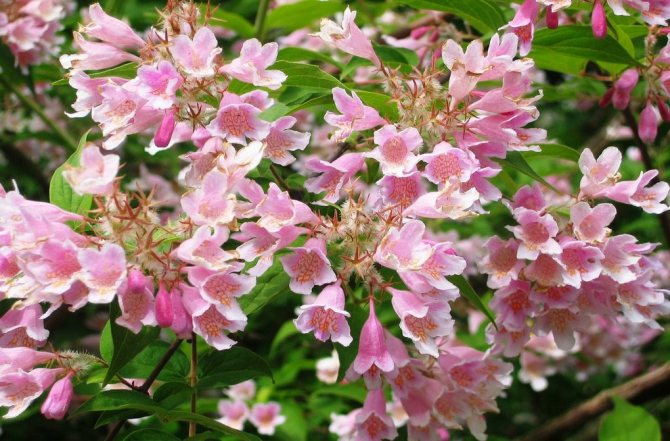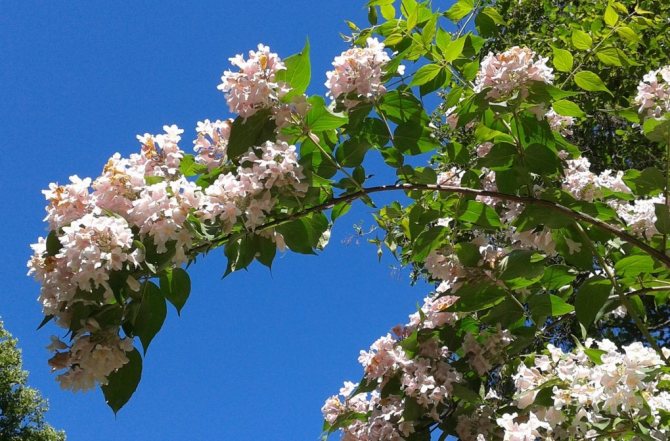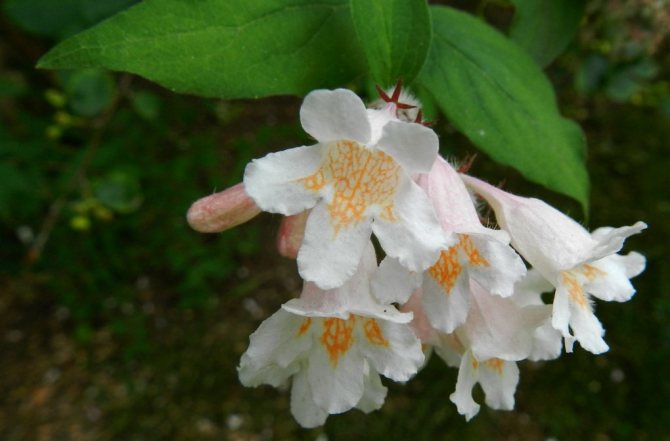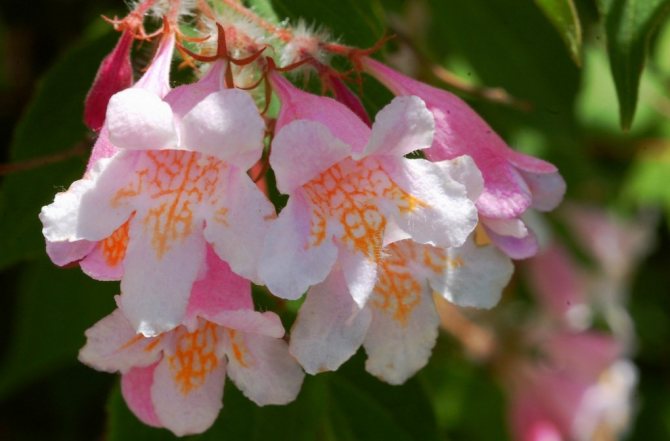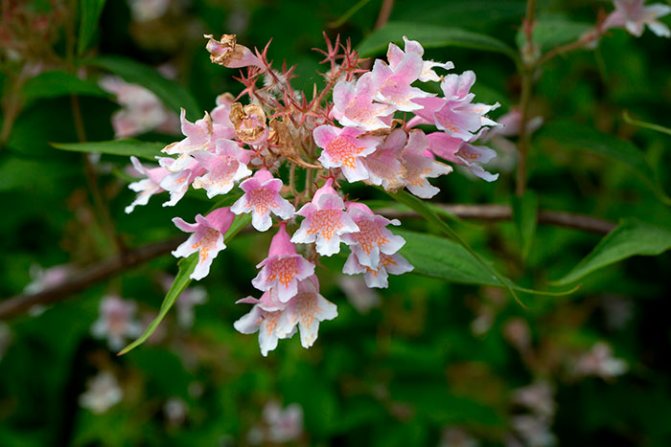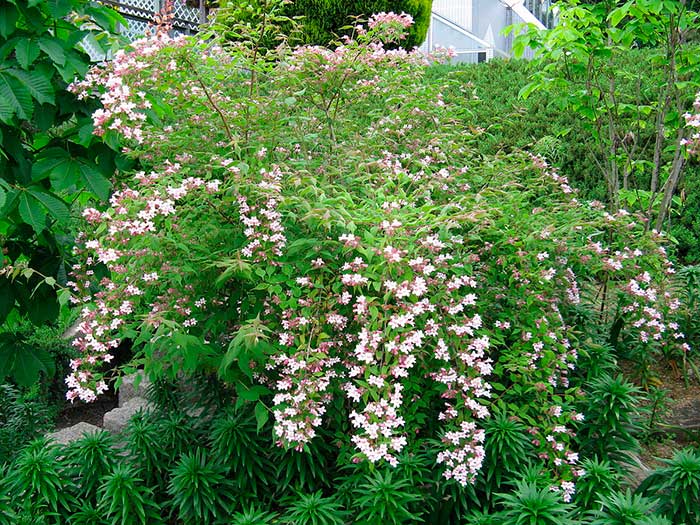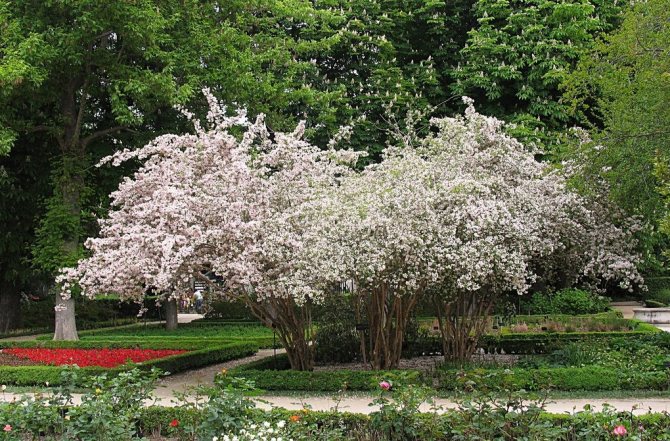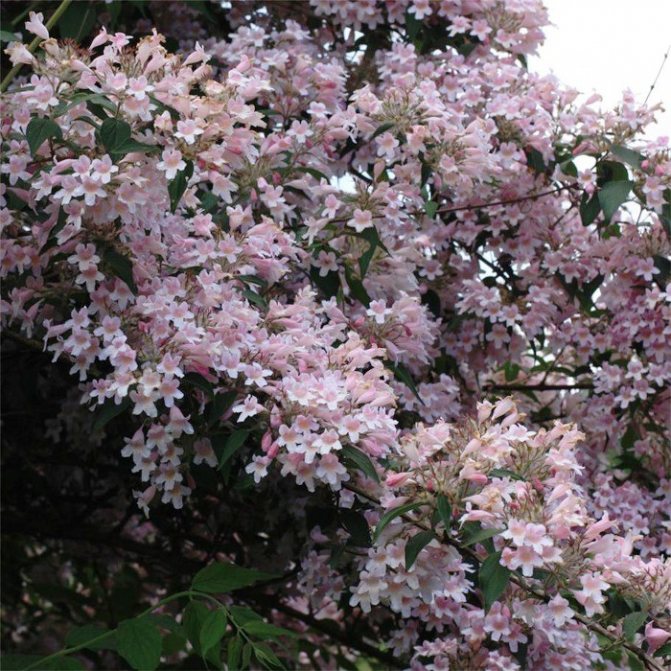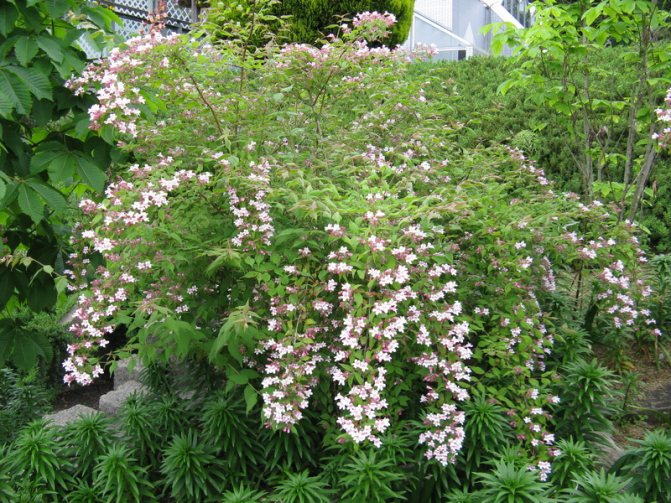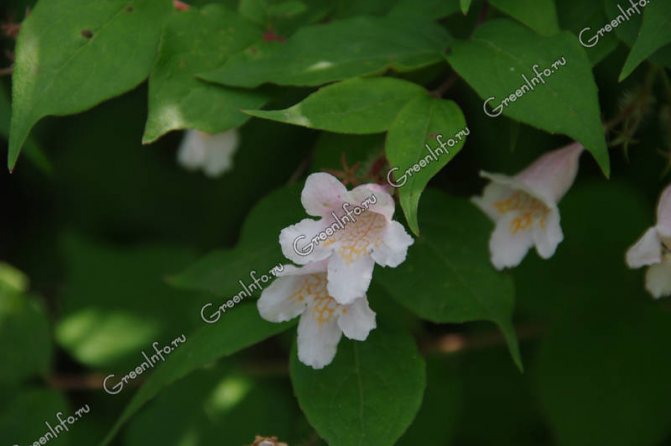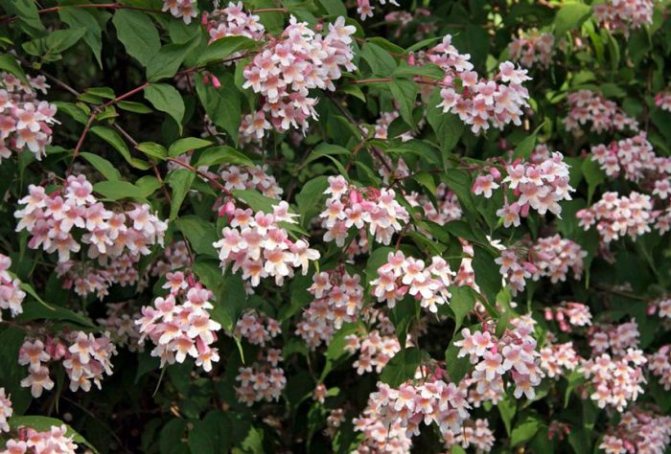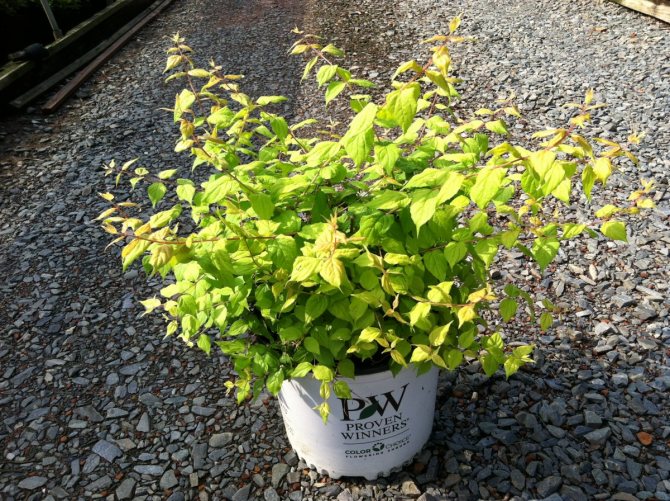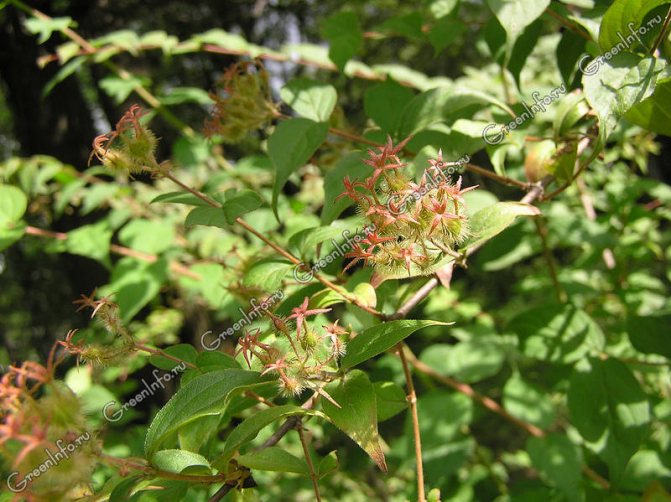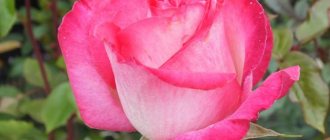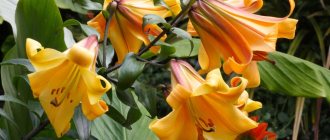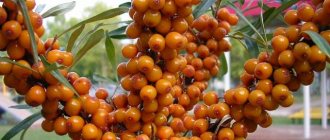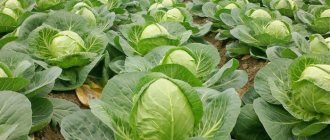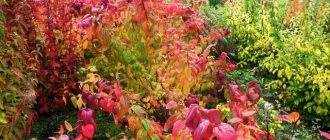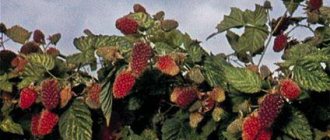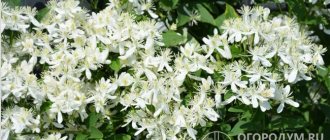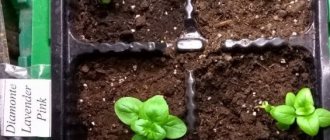Kolkvitsia (lat.Kolkwítzia) is a monotypic genus of the Linnaeus family. The name was given in memory of the German botanist Richard Kolkwitz. Like many Chinese settlers, the flowering deciduous shrub has amazing charm and good adaptability to rather harsh growing conditions. In areas with a temperate climate, it is used as a flowering ornamental plant.

Colquitia
Description of flowering shrub kolquitia


Kolkwitzia amabilis is a monoecious (on which flowers of both sexes are placed) deciduous shrub of the Honeysuckle family. The homeland of the plant is Western China. It was brought to Europe over 100 years ago, but has not yet been widely used in landscape design. One of the names of the plant is pleasant colquitia.
The main species characteristics:
- A multi-stemmed shrub with a spherical crown and abundant root growth. Its height is up to 3 m, width - up to 4 m. A cultivated plant can be more compact - 1.5 - 2 m.
- At first, the straight branches, growing, bend in the form of an arch, leaning towards the ground under the weight of flowers.
- The bark of the shoots of colquicia is lovely thin, reddish-brown flakes off in plates.
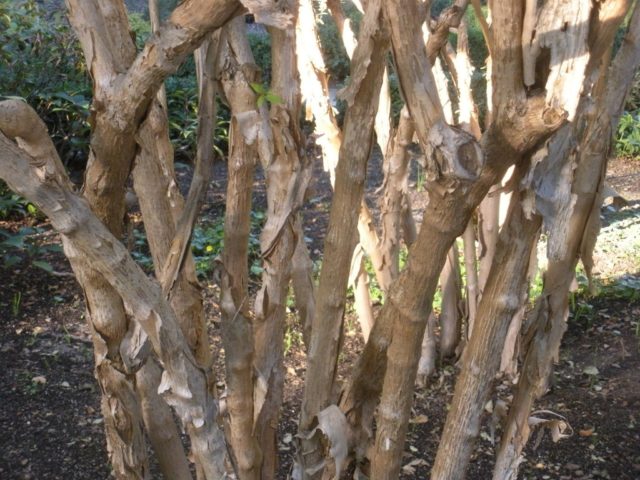

- The wide leaves are oval, pointed towards the top. They are located opposite. Their length is 3 - 7 cm. Their edges are shaggy. In the upper part, the leaves are dark green in color, lightening towards the base. In autumn, they turn bright yellow and red.
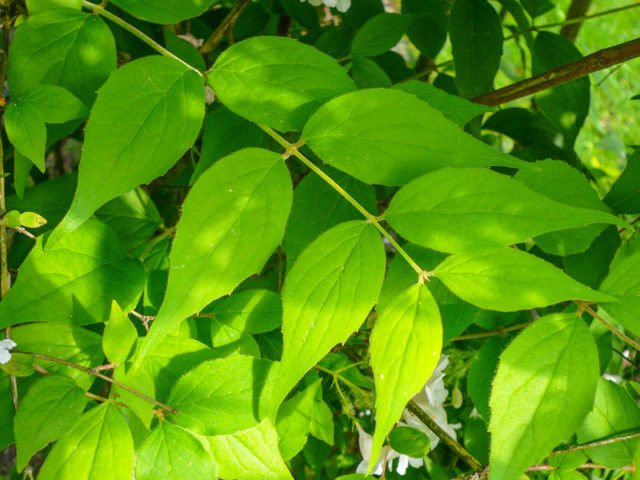

- The flowers, about 1.5 cm in size, have a light aroma, are collected in corymbose inflorescences and are located at the ends of the shoots. Their shape is bell-shaped, five-bladed. The color of the flower of colquicia is adorable - light pink with a lilac tint, inside the pharynx there is an orange pattern. Pedicels are omitted.
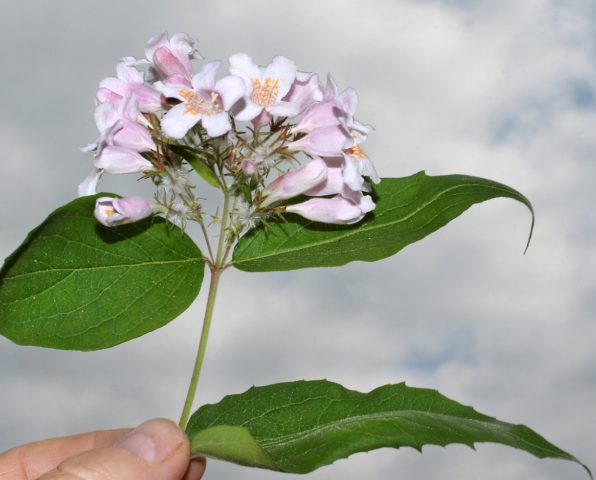

- Single-seeded fruits ripen by autumn. They are dry, covered with bristles and look like a brown box. They form seeds that are characterized by poor germination.
This description and specific features of the lovely colquation are detailed in the photo:
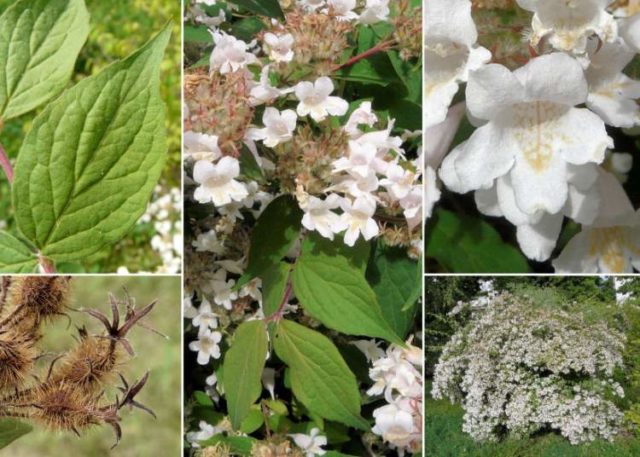

Important! The plant is named after the part of the German botanist Richard Kolkwitz.
The shrub grows well and blooms profusely in any garden soil. For him, it is preferable to have a sunny spot, the culture feels good in partial shade. Kolkvitsiya adorable is characterized by the properties of frost resistance and endurance in an urban environment.
How and when colquitia blooms
Blooming colquia is lovely and looks very graceful. Its delicate pink flowers, reminiscent of mother-of-pearl, cascade on hanging branches. The flowering of the shrub is abundant: the foliage behind the flowers is almost invisible. They attract insects with their sweetish aroma.
The growing season of the plant is mid-April-November. The lovely colquicia blooms from the age of five in spring or summer, depending on the climate of the growing zone. In the middle lane, it blooms in early July, later than other ornamental shrubs. Flowering lasts more than three weeks.
Attention! For the flowers of the charming colquitia, it is characteristic that they do not fade, but fly around, being in bloom.


Application in landscape design
According to experts in the field of landscape design, the charming colquction looks most advantageous as a tapeworm in various compositions:
- An accent element on a green lawn. The lovely kolkvitsiya are planted individually on a well-groomed area. When trimming, they give it a neat spherical or fountain shape.
Advice! Kolkvitsiya adorable goes well with the texture of stone and dark wood.

- Group planting of a lovely colquition. A shrub planted in the form of a hedge looks spectacular. In this way, you can give privacy to the recreation area in the garden or the splendor of the central entrance of the personal plot. By combining different varieties of lovely colquitsia in a group planting, they create low-contrast color transitions from dark pink to almost white.
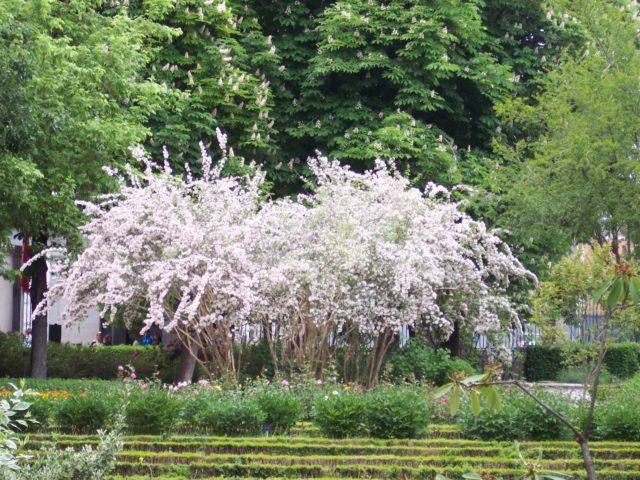

- Contrasting compositions. The light color of the flowers of the adorable colquitia is emphasized by darker deciduous, coniferous or brightly flowering plants. In autumn, its yellow or red foliage sets off less colorful shrubs. Vegaila and hawthorn emphasize the tenderness of the flowers of the culture.
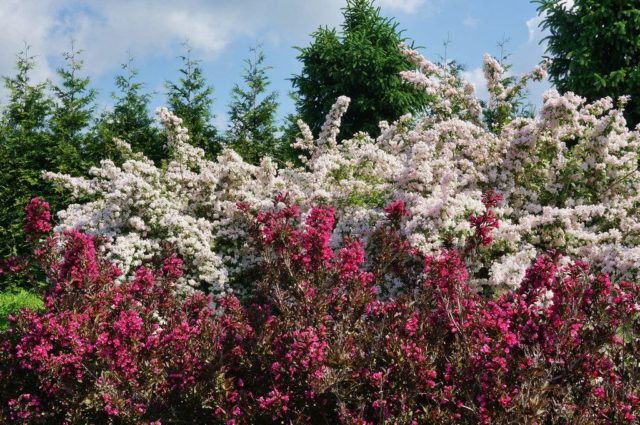

- Mixborders. The delicate pink flowers of the lovely colquia highlight the central part of the shrub group. It is positioned as a tapeworm and is surrounded by lower plants.
Important! A free-form flower bed is called a mixborder.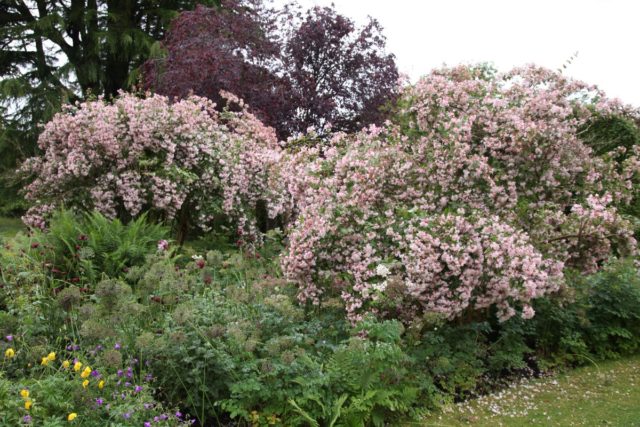

Photo gallery
Varieties of wonderful colquation
There are few varieties of this plant. They are highly decorative. Heat-loving and not hardy enough, varieties of lovely colquitia require special conditions for planting and care. For cultivation in temperate continental climates of the middle zone, Pink Cloud, Rosea and Dreamcatcher varieties are suitable.
Pink Cloud


The Pink Cloud blooms more abundantly than the original colquitia cultivar. The shrub is smaller. At the age of five, it reaches a height of 0.8 m. Its maximum size is 2x2 m. The variety is frost-resistant and drought-resistant. Its shoots grow vertically, and the appearing pale pink flowers almost completely hide them.
Rosea or Rosea (Rosea)
Rosea begins to bloom with bright pink bells, which, as they bloom, acquire a light pink, almost white color. The shrub lends itself well to pruning. Perfect balls are formed from it, which are completely covered with flowers. The shoots of the culture hang down beautifully in the form of a fountain. In autumn, the leaves turn orange.


Dream Catcher Beauty Bush
A common name for this variety is Maradco. Its main difference from other varieties is the more compact size of the bush. The golden-orange hue of the leaves and the abundant flowering are another varietal feature of this charming colquation. The culture is also disease resistant.
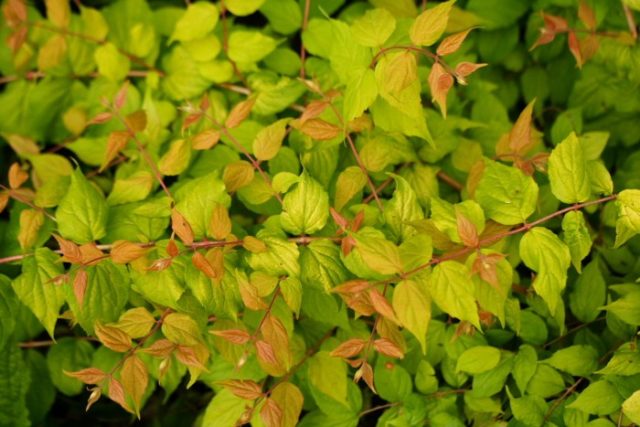

Important! The adorable kolkvitsiya can be grown in the middle lane, in the southern regions of Russia, as well as in the Moscow region.
Description of the lovely colquation Pink Cloud
Perennial, flowering, deciduous colquitia Pink Cloud (pink cloud) adorns European Botanical Gardens. In Russia, the lovely colquicia is grown from the European part to the South. The plant feels comfortable in a temperate climate.
Cultivar Pink Cloud is a variety with high frost resistance. Resists temperature drop down to -28 0C. Freezing of young shoots is often noted, but this negative factor does not affect the abundance of flowering, colquification completely forms a replacement until the moment of budding. Every year, up to 4 years, the plant adds in height and width within 30 cm. When the maximum height of 1.8-2.2 m is reached, the growth stops, the growing season is aimed at budding and the formation of shoots.
Description of the habitus of the lovely Pink Cloud colquation:
- Sprawling shrub with a dense crown formed by numerous thin, drooping shoots. Old stems are dark red, rough, with partially peeling bark. Shoots of the current season are one tone lighter than perennial ones, their surface is densely covered with fine pile.
- Leaves of various lengths from 4 to 8.5 cm. The largest are formed at the beginning of the branches, the size decreases towards the top. The plate is in the form of a narrow elongated oval with a sharp top. They grow oppositely, in pairs. In the spring and summer, the color is dark green, in October it is bright yellow with an orange tint.
- Mixed roots, central deep, superficial fibrous. The accessory buds of the root system give numerous shoots.
- The fruits are dry, the surface is small-bristled, small in size with two seeds. Ripen in early autumn.
The planting material after the opening of the seed pod scatters, germinates the next spring.
Important! Seedlings are fully consistent with the characteristics of the parent bush, suitable for subsequent reproduction.
Features of reproduction of colquitsia
The adorable kolquicia, like other perennial shrubs, is propagated by seeds, cuttings, layering or division.
Seeds
The seeds of the plant have a low germination rate - 25 - 35%, which must be taken into account when choosing this method of reproduction. With such a cultivation of the charming colquitia, special attention is paid to the nutrient substrate. It is made up of peat and sand, taken in equal proportions.
The seeds are planted in early April. To protect the shoots from late frosts, they are placed in a greenhouse or at home in a pot. The sprouts sprout by the beginning of summer, and in August they grow by almost 20 cm.
Procedure for reproduction of colquitia with adorable seeds:
- Prepare the seeds. For this, the seeds are subjected to stratification for two months: they are stored in a refrigerator at a temperature of 1 - 3 ° C in an airtight bag with wet vermiculite or a napkin. To accelerate germination, the seed is soaked for 10 minutes. in sulfuric acid.
- Deepen the seeds into the substrate by no more than 0.5 cm and spill abundantly.
- The next spring after planting, it is important to dive the plant and plant it in a permanent place.
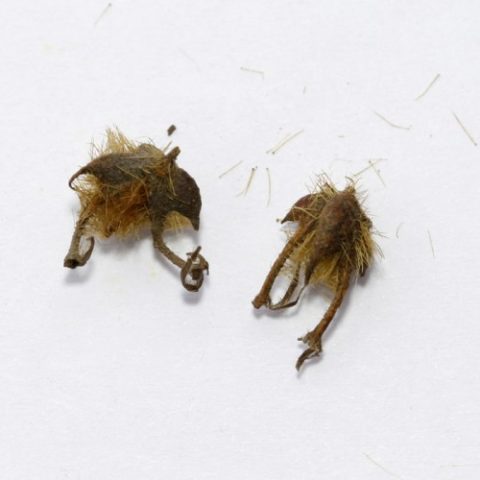

Attention! The seedlings have low resistance to frost, so they are not planted in open ground in the fall.
Layers
The most effective way to reproduce a lovely colquition is by layering. The sequence of actions is as follows:
- A coppice shoot growing outward of the bush is chosen.
- A small groove is dug under it.
- The shoot is tilted and placed in a groove.
- At the point where the shoot touches the ground, it is slightly incised and treated with a growth stimulant.
- The shoot is fixed with a hairpin and sprinkled with soil, leaving the top free.
- The soil is constantly kept slightly moist during the summer.
- The next spring, after rooting, the cuttings of the lovely colquicia are separated from the mother shrub and transplanted to a permanent place.
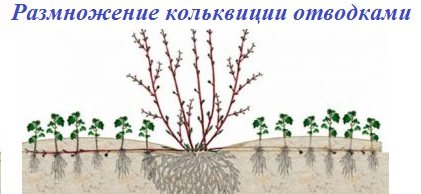

Cuttings
Important! Reproduction of kolkvitsiya by lovely cuttings due to their low frost resistance is possible only in areas with mild winters.
Cutting is carried out in one of the ways:
- Lignified cuttings. At the end of autumn, a lignified twig is cut off from a charming bush and added to it in a shaded place. By winter, cuttings are mulched with hay, straw or foliage. With the arrival of spring, they are opened. Over the summer, the shoots will take shape and take root. The next spring, the young plant is transplanted to the desired location.
- Annual cuttings. In early spring, one-year-old shoots are separated from the mother bush and cuttings are cut. Then, for rooting, they are planted in containers with soil mixture and kept in a warm place. At the beginning of summer, the cuttings are taken outside in the shade and watered regularly, preventing the soil from drying out.After the appearance of young shoots, they are transplanted into open ground in a shaded place and continue to be watered. Before the onset of winter, the plants are covered. In the spring, a lovely young colquation is transplanted to a permanent site.
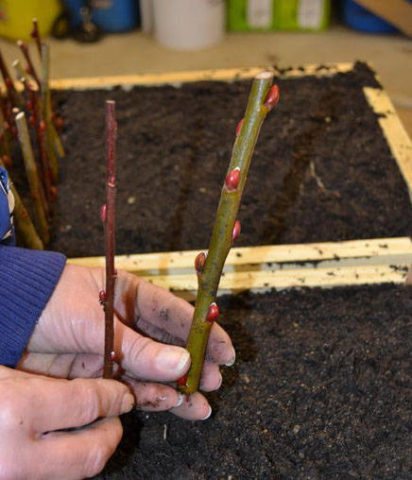

By dividing the bush
The method of reproduction by dividing the bush is advisable to use when transplanting a lovely colquitia. They do it this way:
- The plant is carefully dug up.
- A thorough examination of the root system is carried out. Rotten and dry roots are removed.
- The bush is divided into 3 - 4 parts so that each division consists of a healthy shoot and good roots.
- Sections are treated with garden varnish or sprinkled with crushed coal.
- New plants are planted in pre-prepared holes according to the scheme adopted for kolkvitiya.
Attention! The best time for dividing the adorable colquitia shrub is early spring.
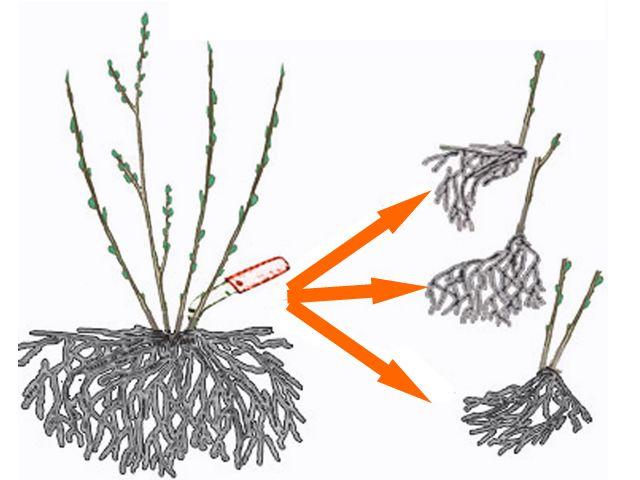

Shrub propagation methods
You can go one of 5 ways:
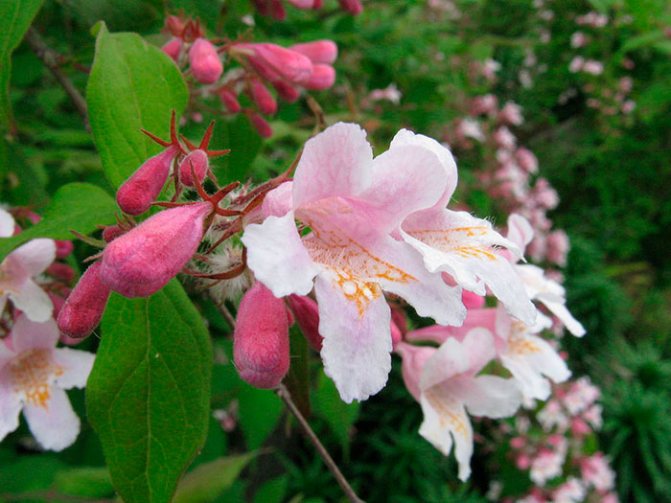

- Collect and then sow seeds. The material must undergo stratification (2-3 months) and scarification procedures. In the spring, kolkvitsiya is grown for seedlings, before winter it is sown directly into the ground.
- Split the "parent" bush in the fall. Each piece should have a good stem and curled root. Planting is similar to rooting a purchased seedling.
- Prepare cuttings of kolkvitsiya. In the summer, these will be green shoots, in the fall - lignified. The first option is good for mild winter climates. Cuttings are planted in greenhouses. Lignified shoots are wrapped in polyethylene and stored in the basement or rooted in the garden, protecting them from frost.
- Use the formed overgrowth. Together with the roots, it is separated from the bush and transferred to a permanent place.
- Propagate the colquation by layering. It is necessary to pin the lower shoots to the ground, sprinkling them with earth. After the appearance of new branches, you can separate the young specimens from the adult plant.
A well-groomed bush looks luxurious. Due to the abundance of flowers on it, it is even difficult to see the foliage. Add peonies, irises, Japanese spirea, robinia to the perennial company. They will beautifully emphasize the originality of the lovely collection.
Planting and caring for kolkvitiya in the open field
Cultivation of kolkvitsiya in the middle lane, in the south of Russia and in the Moscow region requires adherence to the rules of planting and caring for the plant. Agrotechnical measures for this culture are not difficult and are available even to novice gardeners.
Recommended timing
It is recommended to plant the lovely kolquicia in open ground in the spring, when the soil in the root layer warms up well:
- end of March - for the southern regions;
- early April - for the middle lane;
- mid-end of April - for the Moscow region and territories located to the north.
Attention! In areas with non-severe winters, autumn planting of the lovely colquia is possible.
Site selection and soil preparation
The place for planting a lovely colquition must meet the characteristics:
- be well lit, but openwork partial shade is allowed;
Important! In the shade, colquitia blooms sparsely.
- protected from gusts of wind (for example, against a wall of a building or a fence);
- groundwater should not run too high, stagnation of rain or snow water is not allowed;
- the shrub grows well and blooms on fertile, loose and weed-free soil: ideally, it should contain humus, sand, compost and leafy soil.
Important! Alkaline or neutral soil is preferable for kolkvitia charming. Acidic soils are lime or wood ash is added to them.
How to plant a lovely colquition
One- or two-year-old healthy seedlings with well-developed roots are chosen for planting. In order for the adorable colquia, regardless of the selected variety, to take root well and bloom thickly, adhere to the following planting algorithm:
- Prepare a hole 60x60x60 cm in size.When group planting, the distance between the bushes should not be less than 1.5 m.
- Pour a fertile mixture of earth, humus and sand at the bottom of the pit in a ratio of 2: 1: 1.
- Install a sapling of a lovely colquitium in the hole, making sure that its root collar is not buried.
- Spread the roots of the plant.
- By adding soil in portions and watering each layer with a small amount of water, fill the planting hole.
- Lightly tamp the trunk circle.
- The final stage of planting is watering and mulching the soil around the seedling.
How to plant kolkvitsiya in the suburbs
The order of planting the lovely colquity in the Moscow region and the Moscow region does not differ from the generally accepted scheme. Prepared seedlings are placed in holes, sprinkled with earth and watered. The soil must be mulched. This helps to retain soil moisture and keeps the roots from overheating.
Use in landscape design
The spectacular flowering of kolkvitsia deserves a special, dominant location in the garden, in the center of the landscape composition. In single plantings, it attracts the eye on a well-groomed green lawn, a terrace, against a background of brown-red structures.
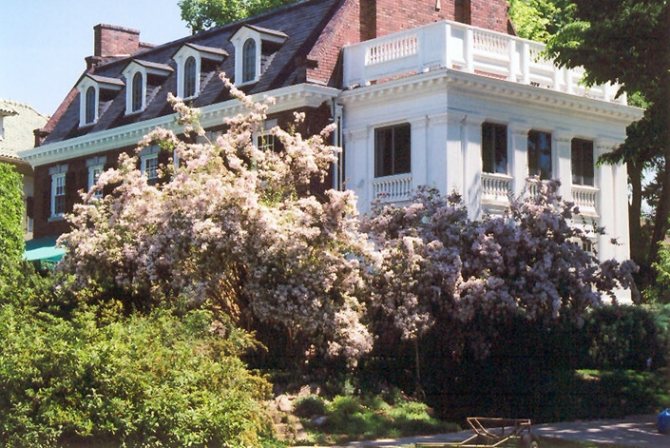

Colquitia bushes near the house
Kolkvitsiya is often planted in places where peonies, irises are located, they look amazingly harmonious against the background of a soft pink beauty. With other perennial shrubs, such as weigela, deytsii, forms a dense, beautifully flowering hedge along the border of the site.
Group plantings of colquitsia form lush pink clouds, which are combined with a blue background of Himalayan geranium, Narbon flax, blue blue. At the foot, you can arrange a silvery-white carpet of chippings, or a brick-red cover of dwarf barberry bushes, which favorably set off the dignity of a charming neighbor. Crimson and pink go well in a pair of colquicia with robinia. Lower shrubs, for example, Japanese spirea, holly mahonia, can serve as a good addition to the group.
Colquitia transplant
An overgrown shrub can be transplanted every five to six years to a new location. This is best done in the spring when the air temperature has stabilized. So the plant will root well and give young shoots. Kolkvitsiya adorable tolerates a transfer to a new place well. It takes root quickly and blooms well. At this time, you can propagate the bush by dividing. Algorithm for transplanting an adult plant or seedling with a closed root system:
- The shrub is carefully dug up or removed from the container, taking care not to damage its roots.
- A planting hole is prepared with a size exceeding the dimensions of the root system with an earthen clod.
- Pour a nutrient-rich soil mixture into the hole.
- The bush is placed in a planting nest, its roots are covered with earth, avoiding deepening the root collar. The soil is compacted.
- The transplanted colquitia requires abundant watering and mulching of the trunk circle.
How to plant kolkvitsiya on the site
The original decoration of the garden will be a spherical shrub, formed about 7-8 years after the start of growing colquitsia. To do this, even during planting, you need to take into account that at least 2 meters of free space should remain around the culture. It is better to choose a sunny place in order to fully enjoy the abundant flowering. Partial shade is also acceptable. The main thing is that there are no drafts and constant sunshine.
Advice. For planting, choose seedlings 1-2 years old.
The optimal time for rooting a young bush is spring. Plant the colquation in well-heated, nutritious, lightweight, well-drained soil. It should be neutral, with no tendency to stagnate water. There is nothing complicated in the planting process itself:
- 2 weeks before the scheduled day, dig a hole 40 cm deep.Length and width - 50-60 cm.
- Fill the hole with nutrient mixture. Its composition is 1 part sand and 2 parts each compost and sod land. Prepare the soil with a margin: it will come in handy during the rooting of the colquitia.
- On the day of planting, shorten the roots of the seedling.
- Add a bucket of ash and 80-130 g of complex mineral dressing to the hole.
- Install a bush, cover it with prepared soil mixture.
- Tamp the earth and water the bush. When the water is absorbed, mulch the plant.
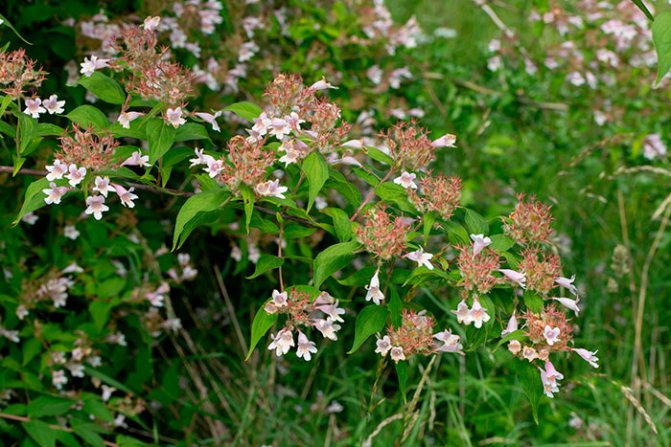

Growing features
Kolkvitsiya adorable is able to withstand frosts down to -15 0С. According to the reviews of domestic gardeners, she is not afraid of short-term frost down to -30 0С.
Watering and feeding schedule
The adorable kolquicia withstands a short drought, but for good flowering and development, it needs regular watering. Water the bush, preventing the soil from drying out, while using water that is settled and warmed up in the sun. The best time for the procedure is evening.
Important! The rule of feeding a charming colquition says: it is better to underfeed the plant than to overfeed it.
An excess of fertilizers reduces the winter hardiness of the plant and activates growth processes, which lead to a deterioration in the flowering of the shrub. Top dressing is applied according to the following schedule:
- with rotted organic matter and mineral additives, the culture is fertilized 2 - 3 times during the growing season;
- if the plant develops poorly, use liquid top dressing in the form of superphosphate (40 g per bucket of water) or mullein infusion (1:10).
Nutrient mixture consumption - 10 liters per bush.
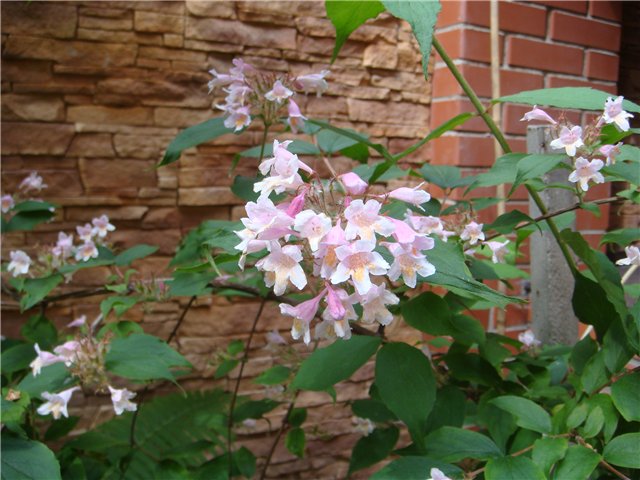

Pruning kolkvitsiya
The adorable colquitia needs gentle, formative pruning. They try not to cut the lateral and upper branches, as this can negatively affect the flowering of the shrub. In the summer, the unripe tops of the shoots are shortened, which helps to strengthen their bases.
Rejuvenating pruning is carried out after the lovely colquia has faded. Old shoots are cut under the base. Since spring, the plant will direct all its forces to form the growth of young branches. They will start blooming next year.
Sanitary pruning is carried out with the onset of spring. At the same time, branches damaged by frost and pests are removed.
How to cover colquction for the winter
Successful wintering of the adorable colquia, especially in the middle lane and the Moscow region, as well as in areas with severe frosts, is possible only with proper preparation. It begins in the fall, without waiting for early frosts:
- reducing watering of the bush;
- stopping fertilizing after flowering ends;
- mulching for the winter the root zone of the leaf, compost with sawdust or peat, while laying a layer with a thickness of at least 5 - 10 cm, which protects the soil from freezing.
Advice! The radius of the soil mulching zone around the shrub of the charming colquitia should be equal to or exceed the dimensions of the projection of its crown.
The best protection of a plant from frost is its shelter for the winter. The crown of young plants is wrapped with non-woven covering materials or kraft paper. Effectively bending the shrub to the ground, followed by laying spruce branches on it. Then a layer of snow up to 30 cm thick is thrown on top, under which the plant will safely overwinter. With the onset of warmth, the lovely colquation must be freed from the covering materials in order to prevent it from becoming rotten.
Important! Kolkvitsiya adorable after freezing has the property of completely recovering, provided that the root system of the plant is not damaged. Unripe young shoots are prone to freezing, so in the fall they are all removed.
It is possible to grow a blooming, healthy, disease-resistant shrub, as in the photo, only with proper planting and competent care of the colquitia.
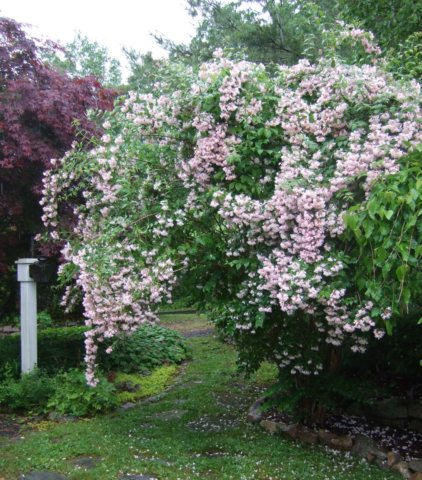

Growing in the suburbs
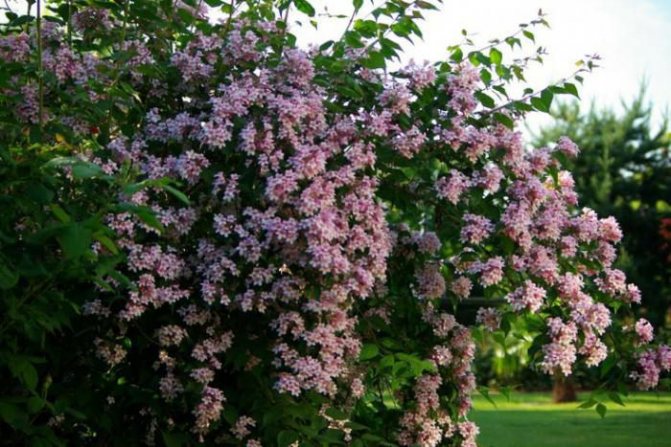

If kolkvitsiya is grown in regions with a cold climate, then its young shoots do not always have time to ripen before winter, and therefore, in the springtime, dry tips can often be seen on the bush. They should be cut before the plant blooms. In order for the shoots to ripen faster, when the bush fades, it is necessary to reduce watering, stop applying fertilizing, and also cover the trunk circle with a layer of mulch (peat or compost combined with sawdust or foliage), the thickness of which should be from 5 to 10 centimeters. This will not only protect the roots of the plant from winter frosts, but also force it to accumulate nutrients. In late autumn, you need to cut off almost all young growths. In this case, lignified stems with a small number of young growths should remain on the bush.
Pests and diseases
The shrub has disease and pest resistance properties. But in dry and hot weather, it can be attacked by spider mites, thrips, aphids and caterpillars. In this case, the crown is treated with a solution of insecticides for flowering plants.
The following problems may arise when growing a plant:
| Problem | Cause | Recommendations for elimination |
| Bad bloom | Insufficient illumination. | Remove shading objects or replant a bush. |
| Improper use of fertilizers. | Correct the feeding scheme. | |
| Low soil nutritional value. | Fertilize the bush. | |
| Dying off of young shoots | Freezing of a plant in winter. | · Remove damaged branches; · For the winter, the bushes must be covered. |
| Decay of the root system | Stagnation of moisture in the soil. | Make drainage. |
How the pleasant pink cloud blooms
The decorativeness of the Pink Cloud colquity is fully manifested only during the flowering period. The timing of budding in a shrub depends on the climate. In the South, it blooms at the end of May, in the Moscow region - in early June, in Siberia 2 weeks later. The flowering period does not depend on the region, its duration is 28 days. The flowers dry, turn yellow, the shrub looks untidy. Therefore, the inflorescences with the tops of the shoots are cut off.
This cultural feature is fully compensated by the flowering period. The bush is completely covered with numerous corymbose inflorescences. The flowers are bell-shaped, five-petal, light pink outside, inside in the throat area orange with yellow longitudinal stripes, fragrant. In the photo, the lovely Pink Cloud is at the peak of flowering.
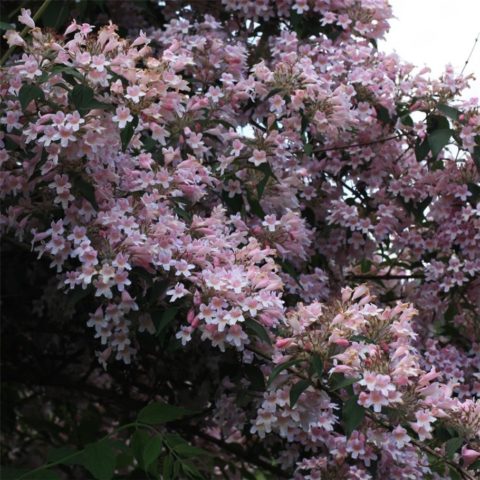

A flowering shrub is used in ornamental gardening as a tapeworm, included in compositions with dwarf conifers, and grown to create an unformed hedge.
Pruning and preparing for winter
Crown pruning is carried out throughout the season. This procedure is sanitary and anti-aging. It is carried out in several stages:
- In the spring, before the beginning of the formation of buds, a sanitary pruning of the crown is carried out. At this time, all damaged, dried and weakened shoots are cut off.
- The second pruning is done when the shrub is finished blooming. Faded and young green shoots are shortened by one third of the length or slightly less. If you do not cut these branches, they will not have time to woody before winter and will die from frost.
- Excessive young growth is removed throughout the season.
- Anti-aging pruning is carried out for old kolkvitsia bushes. In early spring or after flowering, old stems are cut to the ground. Soon after this procedure, the plant will start up new shoots, and the next summer they will begin to bloom.
Kolkvitsia is pleasant - a culture that is highly resistant to frost. But for the plant to survive the winter favorably, it needs snow cover and protection from the wind. Some varietal specimens and young twigs can withstand temperatures of at least -25 degrees. They can suffer from frost even with good snow cover. If the root of the plant has not suffered from the cold weather, the shrub will be able to recover in spring, although its decorative qualities will be lower.
To protect varietal shrubs from freezing, they must be covered for the winter. In the fall, an additional layer of mulch is poured onto the plot of land around the roots. The crown of the plant is protected by spandbond or other covering material. Young shoots can be bent to the ground and overlaid with spruce branches; snow protection is created on top. With the onset of the warm season, the shelters are removed.
The main varieties of Kolkvitsiya Prelestnaya
Based on the type of Kolkvitsiya Adorable, breeders have developed various varieties that differ from each other in the size of flower buds and their color.
In Russia, Ukraine and Belarus, the most common varieties are Kolkwitzia Rosea, which is distinguished by its bell-shaped flowers of a dark pink hue, and Kolkwitzia Pink Cloud, whose flowers have a delicate creamy pink color and a throat with yellow-orange stripes.
Attention! It must be remembered that, unlike the main type of culture, its varietal specimens are less frost-resistant, requiring shelter for the winter period.
From spring to late autumn
Retains decorative Kolkvitsiya adorable. Landing is usually done in late March - early April. After a couple of weeks, the plant is covered with green foliage. Young shrubs usually do not bloom, that is, the first 3 years will have to be content with the appearance of the bush itself. The first flowering has not been observed for the fourth year, but it is still quite modest: separate inflorescences are located on the branches. The bush will become a fluffy cloud about 7-8 years after planting.
In the middle of summer, the mature shrub is densely covered with flowers. Even foliage is difficult to see because of them. The buds are rather large, reaching 1.5 cm in diameter. Their second advantage is their amazing aroma. Delicate bells are collected in inflorescences.


Choosing a place for planting kolkvitsiya
- Kolkvitsiya is a light-loving plant, which is why when choosing a site for planting it is necessary to give preference to well-lit places. The shrub can also grow in the shade, however, in this case, it can stretch too high in height.
- Kolkvitsiya, according to gardeners' reviews, is distinguished by its unpretentiousness. It grows on ordinary cultivated garden soils. With high groundwater levels, good drainage is essential. The most suitable for planting kolkvitsiya are sandy loam soils with good fertility.
- When choosing a site, you should take into account its relief. This shrub should not be planted in the lowlands. Firstly, stagnation of melt or rainwater can form there, and, secondly, frosty air can stagnate there in winter, which is also undesirable for colquation.
Mister summer resident informs; features of planting kolkvitsii in the suburbs
Kolkvitsi seedlings grow in the temperate climate of the Moscow region. Of course, the soil plays an important role in the formation of the bush. Loose, nutritious soil is the key to the success of the rapid growth of colquitia and the formation of peduncles. In a dry period, the soil is moistened, and a thick layer of mulch is laid to retain moisture, it is good if it is peat and compost, and pine bark on top.
After watering, the bark wood will be saturated with moisture, and if the dry period comes, it will not let the roots dry out. In the Moscow region, they must protect the bush from severe frosts, so that in cold, snowless winters, the plant is as covered as possible, it directly touches young seedlings. It is necessary to cover not only the crown, but also the root system, this is especially important in snowless winters.
The lovely colquition is pleasant in its beauty of an airy pink cloud. With proper care, after 6-7 years, a beautiful and lush tree will form, with spreading branches in the form of a ball.
Having planted this beautiful bush in a country house, in the country you can count on its gorgeous flowering and summer aroma with brightly colored autumn foliage.
Kolkvitsiya in culture
Brugmansia planting and care in the open field, as well as breeding at home
The plant was first introduced to Europe in 1901, the first flowering was observed in 1910.
Kolkvitsiya is grown in gardens of temperate and cool climates. The plant is prized primarily for its abundant flowering. Since after the end of flowering, colquitia is not too decorative, it is recommended to plant it surrounded by such plants that look decorative throughout the season; another planting option is as a single plant against the background of a well-groomed lawn.
Kolquicia is photophilous, but it can develop well in a shaded area, for example, among large trees. Prefers well-drained fertile soil with moderate moisture. It can grow in both acidic and alkaline soil.
It is advisable to choose a site for planting such that in winter it is protected from strong winds. Kolkvitsiya is quite winter-hardy, withstands frosts down to about minus thirty degrees, but in cold winters, young shoots often freeze.
Planting is advisable in the spring, when the soil has already warmed up enough. The planting hole should be about half a meter deep and in diameter, it is filled with a mixture of humus and sand. The plant begins to bloom the next year after planting.
Care measures:
- in spring it is recommended to carry out sanitary pruning: cut out frozen branches;
- in late spring, mulching is carried out with chips, crushed bark or peat up to 10 cm thick; the contour of mulching should correspond to the projection of the contour of the bush or exceed it by 15 cm;
- after flowering, faded shoots are shortened;
- in the fall, after the onset of stable negative temperatures, repeated mulching is carried out.
Reproduction:
- seeds - you can plant them before winter, or in spring (in the second case, cold stratification is required for two to three months);
- horizontal layering - in this case, young shoots are bent to the ground and buried in the grooves; above the backfill, it is recommended to wire the shoot or cut it;
- dividing the bush;
- green cuttings - in the middle of summer (it should be borne in mind that rooted cuttings have a significantly lower frost resistance compared to adult plants and often freeze out in the first winter);
- lignified cuttings - in the open field in late autumn.
The two most famous varieties are:
- Kolkwitzia ‘Rosea’ - flowers have a rich pink color;
- Kolkwitzia 'Pink Cloud' - bright pink flowers; the plants are larger than other varieties.
Pruning
The bush does not need it, it is rather a necessary measure than a necessity. In the spring, it is imperative to inspect the plantings and cut off damaged, broken or frozen branches. We have already said that this is a very frost-resistant plant, but in Siberia, it often does not have time to prepare for the cold weather, which comes very early and suddenly. Therefore, young shoots often freeze and die off. In the spring, you will see dry twigs. This means it's time to take the pruner in hand and tidy up the bush. Moreover, this must be done before flowering, so that new shoots form.
How colquitia reproduces by seeds
Cultivation of colquitsia from seeds Photo of seedlings
Seeds should be planted in the ground before winter, but it is also possible in spring for seedlings in a greenhouse.
For spring planting at the end of March, cold stratification is carried out for 2 months.
For this, the seeds must be stored in the refrigerator (stage 1: two weeks in the freezer, stage 2: on the refrigerator shelf).
Then the seeds are sown in large containers or in separate pots to a depth of one cm. They are grown in a greenhouse, and planted in the ground next spring.
Classification
The genus Kolkvitsiya is one of five genera of the subfamily Linnaeus (Linnaeaceae
), which is part of the family of the Honeysuckle family (
Caprifoliaceae
).
Taxonomic schema
(according to the APG II System):
| 6 more families, including Valerian, Vorsyankovye, Honeysuckle | |
| view of Kolkvitsiya pleasant (Kolkwitzia amabilis ) | |
| order Teasers | genus Kolkvitsiya (Kolkwitzia ) |
| the Department Flowering , or Angiosperms | family Linnaeans |
| 44 more orders of flowering plants | childbirth Abelia, Dipelt, Zabelia, Linnaeus |
In 2013, an article by a Dutch scientist was published in the journal Phytotaxa, in which the Linnaeus clan was revised (Linnaea
) in order to achieve monophyleticity of this taxon; as a result of this revision, the size of the genus increased to 17 species. The genus included many species of the Honeysuckle family (
Caprifoliaceae
), including the only species of the genus Kolquicia - its correct name for this approach is Linnaea amabilis (Graebn.) Christenh ..
Types and varieties
As mentioned earlier, there is only one type of colquition - adorable.
The colvication is adorable in the photo.
There are also few varietal varieties.
The photo shows a lovely colvication of the Pink Cloud variety.
Pink Cloud - translated as "pink clouds". This is the most popular shrub variety. It can grow up to 2.5 meters in areas with warm climates. In the temperate zone, it rarely grows above 1.5 meters. The diameter of the bush is about the same. It begins to bloom when the rest of the ornamental shrubs has already faded. During the flowering period, the variety lives up to its name. Delicate pink bells cover the bushes like clouds so that you can't even see the foliage. It is a drought-resistant and frost-resistant variety, but requires shelter for the winter. Looks great in group and single plantings.
Rosea is another plant variety. Grows in southern climates up to 2 meters. The shrub needs to be periodically pruned and formed into its crown. During the flowering period, the bush is covered with pink-white inflorescences. At the beginning of flowering, the flowers have a bright pink tint, fade over time. The leaves take on a rich orange color in the fall. The variety prefers the sun and is afraid of winds.
For planting in open ground, you should choose an open sunny area, but without strong sunshine. It can also grow in partial shade. However, in a dark place, the branches of the plant begin to stretch strongly.
The soil must be moist and fertile. In this case, high-quality drainage is very important. In winter, no stagnation of water should form in the soil. The ideal option for planting shrubs is light sandy loam soil.
The best time to plant kolquitsia is spring. The soil must be warmed up. It is recommended to fill the planting pit with a composition of the following components:
All components are recommended to be taken in a ratio of 2: 1: 2.
The pit should be about 1.5 meters deep and in diameter. If a group planting is planned, then it is recommended to leave a distance of about 1.5 meters next to the seedling, otherwise the colquation will not look so beautiful.
This is how monumental and powerful colquction looks like in a climate favorable for it (Europe)
Description of the main features of care:
- Kolkvitsiya refers to drought-resistant crops, but in the hot summer it still needs watering. Watering is desirable in the evening. Water for irrigation needs to be slightly warmed up;
- From the beginning of the growing season to the end of flowering, it is recommended to add mineral and organic additives. Manure and compost are suitable as organic matter. If the plant does not develop well, then it is required several times per season to also feed the culture with liquid dressings, for example, mullein infusion;
- Passion for top dressing is undesirable, since this will lead to poor flowering, as well as to a decrease in frost resistance;
- In late spring, it is recommended to mulch the soil around the trunk. Peat, chips, crushed bark are used as mulch. Re-mulching the soil is required in the fall;
- The culture is calm about the transplant, it is enough just to choose the right place;
- Before the onset of winter, young shoots are recommended to be bent to the ground and overlaid with spruce branches. You can put snow on top in winter. You can also cover the crown with a non-woven fabric. The shelter can be removed around mid-April. With age, the resistance to frost in the shrub increases.
The pink flowers of kolkvitsiya are amazingly combined with irises.
Prevention of freezing
In fact, only one thing is required from the gardener: accelerate the maturation of the shoots so that they can adapt to changing weather conditions. To do this, you need to follow simple rules. When flowering is over, the bush looks lush and green and decorates the garden very well. Therefore, many make the mistake of continuing to water it. At this time, watering is required only in very intense heat, and then in a small amount. Top dressing also needs to be completed. The second point is soil mulching, which will allow the first rule to be carried out painlessly for the plant. Therefore, to a depth of 10 cm, the soil is mulched with the addition of peat, foliage or sawdust.


How do these preventive measures affect the plant? They change the program. Now, instead of active growth, it will accumulate useful elements and strengthen the root system. In addition, if the gardener sees that immature shoots are leaving during the winter, he can cut them himself and form a compact crown. In principle, it is enough to leave the woody branches for the bush to overwinter normally.
Bloom
It is difficult to think of other plants that would be as attractive to the gardener as the adorable Kolquicia. Shrub care is minimal. In the spring, leaves appear first, and in April they reach 8 cm in length. Their top plate is dark and covered with nap. Even the twigs of the shrub are quite decorative. The youngest are green in color. The lower, older branches are covered with dark bark with reddish flaking plates. The branches grow straight, bending downward, which forms a special appearance of the shrub.
Shrub care in the garden
Kolkvitsiya is highly resistant to diseases and pests. Crop care is reduced to regular watering, crown pruning, weed removal and top dressing. Watering ornamental shrubs is not necessary too often, but abundantly. Water must be defended in advance and warmed up in the sun.
To provide the soil with sufficient and uniform moisture and to protect it from overgrowing with weeds, the area around the roots is mulched. As mulch, sawdust and chips, peat, hay mowed are used. The layer thickness can be from 3 to 8 cm.
Fertilizers need to be applied throughout the growing season. As soon as the plant stops flowering, feeding is stopped and the frequency of watering is reduced. This promotes the ripening of young shoots that have appeared this spring, and at the same time prevents the emergence of new ones that will not have time to get stronger before the cold weather.
Before fertilizing, the bush must be watered. The first top dressing consists of nitrogenous fertilizers - nitroammofoska or ammonium nitrate. In the future, the plant is fertilized with organic mixtures - bird droppings, mullein. You can purchase soluble mineral complexes for flowering plants at the store.
You should not overfeed the colquction. Excess nitrogen will cause greenery to grow at the expense of flowers. An excessive amount of mineral fertilizers contributes to the formation of a large number of shoots that will not survive during the winter frosts.
Reproduction
There are two options and you can use them depending on what material can be found in your area. So, colviction is propagated by seeds or cuttings. Of course, in the first case, you will have to wait a little longer until the tiny sprout turns into a luxurious bush. Sowing is best done at the end of March. For this, any planting containers and a mixture of sand and peat are used. The seeds are deepened by about 5 mm, after which the seeds are laid and left for three to four weeks under the film. In extreme heat, plantings need to be ventilated. Four months after germination, they will turn into strong seedlings up to 25 cm high. They are left indoors for the winter, and in the spring, after picking, they are planted in the garden. During the warm period, they will become quite large and strong.
How to propagate colquation
Reproduction of colquitia by seeds
The plant can propagate by seeds, roots or shoots. The longest way to reproduce is by seeds. At first, they are kept in the cold for up to 3 months. In the spring (April) they are sown in a long container in a special soil (garden soil, sand and peat) and covered with foil. Seedlings live in a tub until next spring.
All the time when growing indoors, young plants should be kept in a cool place.
It is important to remember that this way you will get a young and lush plant, but you will not see flowers until the 5th year after planting in open ground. If you need the result now, this is not your option for breeding Kolkvitsia
Reproduction of kolkvitsiya by dividing the bush
Another way to propagate a plant is by dividing the bush. But, this way you will get 1-2 more young bushes. The plant will take root better if it is watered and fertilized abundantly. In general, after splitting the root system, you will end up with several young and flowering shrubs.
Reproduction of colquitsia by shoots
Shoot propagation is the standard way to grow a new Colquitia. This can be done in summer or autumn. Cut the cuttings to the optimum length. Then they are planted in prepared soil. If breeding takes place in July, it is easier to plant the young in small tubs. They will take root there well, and in winter the plants can be taken to the basement. The bottom line is that the delicate organism of young shrubs may not withstand the winter cold.
Autumn seedlings take root better than summer ones and there is much less hassle with them. The half-stiff shoots are folded into a bunch and wrapped in plastic. They can be stored in a basement at low temperatures. In the spring they are planted in a greenhouse and conditions for growth are created.
The root system of plants will develop better if the cuttings are kept in the Kornevin growth stimulator. Youngsters are left in the greenhouse until next spring. During this time, the bushes will gain strength and take root well.
Plants are planted in open ground with an old clod of earth. Thus, the stress for the shrub is minimal. Young bushes will bloom in 1-2 years after planting in open ground.
Reproduction of kolkvitsiya by layering
Reproduction of Kolkvitsia by layering is an interesting way to get new plants. It is quite simple to do. To do this, choose a young branch, make a hole in the ground and, bending the branch down, sprinkle it with soil. Before that, the bark is slightly incised and lubricated with a stimulant for the growth of the root system.
The planting site needs to be watered frequently to keep the ground constantly moist. By the young shoots that will grow from the buds, you will understand that the shrub has taken root. No need to rush to transplant Kolkvitsia. It is best if she stays in the old place until next May.
And only then can you carefully separate the daughter bush from the mother bush and move it to a new place.
An unpretentious plant Kolkvitsiya planting and leaving photos can be viewed with us or on the forums of gardeners. When you do everything right, the bush will delight you with flowers until late autumn.
Short description
The adorable colquitia is a species that belongs to the Linnaeus family. The native land of the plant is the mountainous regions of China. Kolkvitsia, the photo of which can be seen above, got its name in honor of the botanist Richard Kolkwitz.
This branchy shrub outwardly resembles a vygela. The plant can reach a height of two meters. Young shoots of kolkvitsia are pubescent with small hairs.
On old branches of colquitia, the bark acquires a brownish-red tint and flakes off in plates. Around mid-April, young leaves begin to bloom, which have a wide ovoid shape and a pointed tip. Their length is on average about 8 centimeters. The leaves are located oppositely.
Kolkvitsiya cultivation and care
Kolkvitsiya refers to unpretentious plants. It practically does not require serious care in the first year of life.
It is important to water the bush on time, mulch the soil and remove small debris, weeds from under the bush. When the plant blooms, the faded inflorescences are removed
This allows you to prolong the period of beauty and provide young shoots with nutrients.
For the winter, the shrub must be bent to the ground, covered with sawdust and covered with branches of a Christmas tree. Thus, it will be possible to protect the root system, and the plant will calmly survive the cold. The bush can survive the whole frost up to 30 degrees.
In the spring, shoots are carefully examined and cut at the root. Branches that are woody are subject to removal. Only young shoots that are not frozen in winter are left. The plant rejuvenates and will soon bloom magnificently.
With the arrival of spring, the plant needs a complex of mineral fertilizers. The better the care of the shrub, the more beautiful and longer it will bloom. Choose a fertilizer that contains a lot of a substance such as nitroammophoska. This composition helps the plant to actively grow and gain its strength.
Kolkvitsiya has good immunity. She is not afraid of diseases and insects. But, for good protection, you need to spray it from the invasion of caterpillars and insects that feed on leaves.
For planting the plant, choose a place where the wind is not strong. The soil can be of any composition, the plant will take root. But, it will grow lush and large in soil where there is a weak alkaline reaction. Water with plenty of water, but do it infrequently. As mentioned above, the soil is mulched with bark or peat. Such an event is needed to keep the moisture under the bush.
In general, plant maintenance does not take long. At the same time, it will delight you with color for many years.
Biological description
Colquitia flowers
Colquitia fruits
Kolkvitsia is a densely branched deciduous shrub up to three and a half meters high (in the conditions of the European part of Russia - up to two meters).
Escapes
densely pubescent with short hairs at a young age. Old shoots are covered with red-brown bark, which flakes off in plates, as is the case with representatives of the genus Honeysuckle. The annual growth is quite large. Under favorable conditions, the bush gives abundant root growth.
Leaves
opposite, paired, oval, pointed, bright green, 3.5 to 8 cm long. Leaves turn bright yellow in autumn.
The flowers are graceful, up to 1.5 cm long, with a pleasant scent; located at the ends of annual lateral shoots
The pedicels are shaggy and attract attention even before the flowers bloom. Corollas are bell-shaped, five-lobed; outside - pink, inside - yellowish
Kolkvitsia blooms in spring or summer for several weeks, while the flowering is usually so abundant that no leaves are visible under the flowers.
Fruit
- small, dryish, covered with bristles.
Diseases and pests
Periwinkle planting and care in the open field photo
Kolkvitsia is sick only if the rules of care are violated or in bad weather conditions. With an excess of water, the roots may begin to rot - the rotten part must be cut off and treated with a fungicide, but with a widespread fungal infection, the plant may still not survive.
In the heat, pests sucking juices may appear - thrips, aphids and spider mites.
Aphids appear on foliage in black clouds and leave behind a sugary transparent secretion that can serve as a bait for fungal diseases. They fight this insect by washing the branches and foliage with soapy water or infusion of citrus or garlic.
The spider mite also drinks juices and because of this, the foliage turns yellow, curls up and dries out. Also, this pest leaves behind thin cobwebs. They fight him with the same methods as with aphids.
Thrips are the most insidious and dangerous pest due to their rapid reproduction. These worms can infect various parts of the bush, but most often they are the leaves and roots. The affected parts turn yellow, and the root system becomes thinner. If this pest appears, then it is better to immediately resort to poisons.
Actellik or Aktara will help get rid of all three pests, but it is advisable to carry out not one treatment, but several with an interval of 7-10 days.
Sometimes a caterpillar occupies the colquation. If there is little of it, then you can pick up the pest with your hands, and with a large amount, it is better, of course, to resort to poisons.
Kolkvitsia came to Russia much later than the end of the 19th and 20th centuries, but firmly established itself in the gardens. Today, different types of shrubs are grown in almost all regions of our country.
Kolkvitsiya grows up to 1.5 meters in height, it is a fairly wide bush. When the plant is still young, it becomes covered with small hairs; with the time of maturation of the bush, this feature disappears. An adult shrub has reddish bark and oblong leaves. In summer, the leaves are dark green, saturated color; closer to autumn, they gradually change their color and become bright yellow. The most beautiful shrub during active flowering. During this period, it is covered with small pink bells. Inside, the flower is yellowish. A pleasant scent will fill your entire garden.
It is also interesting that the plant can live not only in open land. The kolquicia can be grown in a large bucket or tub and placed on a terrace or balcony. In the conditions of the domestic climate, two types of bushes grow well: Kolkvitsiya "Prelest" and Kolkvitsiya "Pleasant".

